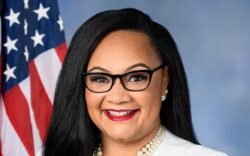I was motivated by a couple of things when I started working on “Trouble in God’s Country” more than a decade ago. The first was that I was convinced by research I was conducting that the socioeconomic divide between Georgia’s haves and have-nots was bigger than generally understood and getting worse year after year after year—so much so that I thought the state was headed for a fiscal and political reckoning. The second motivation was that I felt a great deal of empathy for rural Georgians whose only real sin was that they were born in areas with poor schools, frail health-care systems and limited economic opportunity.
I’m pretty much done with the empathy part.
With the passage and signing of President Trump’s “Big Beautiful Bill,” rural Georgians will soon be getting exactly what they voted for—in particular massive cuts to Medicaid and SNAP benefits. Rural Georgia is Republican Georgia, and Georgia’s nine Republican House members voted in lockstep to pass the bill that will, according to the Atlanta Journal-Constitution, strip about 310,000 Georgians of Medicaid coverage.
The Georgia Policy and Budget Institute had previously estimated the number of Georgians who would lose health coverage at 750,000, but let’s work with the smaller and more conservative number. That’s about 13% of the state’s current Medicaid enrollment. It’s too early to expect any official county-level estimates of cuts, but they’re easy enough to estimate. If the reductions are proportional, the 310,000 lost enrollments will be roughly evenly divided between the 132 largely rural Georgia counties that went for Donald Trump in the 2024 presidential election and the 27 mostly urban counties that sided with then-Vice President Kamala Harris, the Democratic nominee. Overall, the Harris counties will lose about 164,000 to the Trump counties’ 146,000.
But if there’s one thing I’ve learned in my TIGC research, it’s this: When big calamities hit Georgia, they hit Metro Atlanta and other urban areas first, but they take a harder and longer toll on rural Georgia. Moreover, Metro Atlanta is much quicker to recover. That was demonstrably true with the Great Recession; Metro Atlanta took a big hit to gross domestic product and personal income but bounced back within a couple of years. Rural Georgia took much longer to get back to its pre-recession high water mark.
The same was true with COVID, and I’ll be surprised if the adverse effects of the Big Beautiful Bill don’t turn out to be comparable. My 12-county TIGC Metro Atlanta region was home, as of July 2023, to a little over 1.1 million Medicaid beneficiaries, about 21% of the total metro area population. In the other 147 counties, some 1.5 million residents were on Medicaid as of that mid-year 2023 date, about 26.2% of the total population.
The picture for rural Georgia comes into sharper relief when you focus on the 99 counties with populations of fewer than 20,000 people. Assuming not much has changed since mid-year 2023 (these numbers tend to crawl along at a glacial pace), some 30% of the population in those sparsely populated counties is on Medicaid, and those counties gave 71% of their collective 2024 presidential vote to Trump. I guess it’s possible that the 71% that voted for Trump and the 30% that are on Medicaid are on completely opposite sides of the tracks, but I sort of doubt it.
It certainly can’t be the case that there’s no overlap between Trump voters and Medicaid beneficiaries in, say, tiny Glascock County, where 90.9% of the voters went for Trump, and 28.5% of the residents are on Medicaid. Or Brantley County, where 90.9% of voters cast their ballots for Trump, and 33.4% of the population is on Medicaid. Or Echols County, where the split was 90.7% for Trump and 35.4% on Medicaid.
But the Medicaid cuts are only part of rural Georgia’s looming health care problems. Another part is what it means for the rural hospitals that serve them. Hospitals lose money on Medicaid patients, but that doesn’t mean they want to give it up. They’re obligated under federal law to treat patients who show up at the emergency department needing care, regardless of whether or not they can pay, and they lose more money on so-called “self-pay” patients than they do on Medicaid patients. “Medicaid keeps the doors open and the lights on,” one rural hospital CEO told me years ago.
Under the Big Beautiful Bill, a significant number of patients will go from being Medicaid patients to “self-pay” patients—or, as some in the hospital industry call them, “no pay”—and those unpaid bills wind up being rolled into the hospitals’ uncompensated care burden. I did some research on this probably 15 years ago, and found that the amount of uncompensated care being reported annually by Georgia hospitals was just under $1 billion. Now I understand it’s up around $2.5 billion.
To their credit, state officials have seen the tsunami taking shape in Washington and have taken steps to get ahead of it with a bit of fiscal gymnastics that is only slightly less complicated than quantum physics. This is a bit of an oversimplification, but basically the state borrows money from most of the state’s hospitals and uses it to build a kitty that it then uses to attract more Medicaid funds from the federal government. Then the state spreads the lagniappe among the hospitals with the biggest uncompensated care loads. This year, according to a recent AJC article, the Georgia Department of Community Health (DCH) is trying to beef up that pot of money by bringing the state’s private children’s hospitals into the donor pool, a move that might attract nearly $350 million in additional funds.
I say “might” because it’s apparently not a sure thing that the state can get away with using private hospital funds to pump up this particular pot of money. Based on the AJC piece, the state is going to have to get lucky where some of the final language in the BBB is concerned and then pass muster with former television personality and current federal Medicare and Medicaid chief Dr. Mehmet Oz.
Without that relief, Georgia’s rural hospitals stand to lose more than half-a-billion dollars in Medicaid funding by the end of 2034, according to a recently published American Hospital Association study. “The Medicaid cuts in the One Big Beautiful Bill Act would devastate rural hospitals across the country,” said AHA President and CEO Rick Pollack. “Many rural hospitals would be forced to choose between maintaining services, keeping staff and possibly closing their doors. Patients would be forced to travel hours for basic or emergency care, and communities would suffer.”
Since 2015, Georgia has lost nine rural hospitals (only Texas and Tennessee have lost more) and another 18 are reportedly in danger of closing. Georgia is also a national leader in medical debt. A 2022 study by the Urban Institute found that out of the 100 counties nationally with the highest levels of medical debt, 20 are right here in Georgia. And this, of course, is the current state of rural health and health care in Georgia before the BBB even kicks in.
Trump, for his part, campaigned on a pledge not to cut Medicaid and has maintained that position since taking office. As recently as May 4, he told Kristen Welker on NBC’s “Meet the Press” that he would veto the Big Beautiful Bill if it cut Medicaid.
“I would [veto it] if they were cutting it, but they’re not cutting it,” Trump said. “They’re looking at fraud, waste and abuse. And nobody minds that. If illegal immigrants are in the mix, if people that aren’t supposed to be there, people that are non-citizens are in the mix, nobody minds that. Waste, fraud and abuse. But we’re not cutting Medicaid, we’re not cutting Medicare, and we’re not cutting Social Security.”
Trump’s rural Georgia voters will soon have to choose between believing the president or their lying eyes. It’s really hard to feel sorry for them.
Like what you just read? Support Flagpole by making a donation today. Every dollar you give helps fund our ongoing mission to provide Athens with quality, independent journalism.








Rural Georgians Will Feel the Pain From Trump’s Health Care Cuts
I was motivated by a couple of things when I started working on “Trouble in God’s Country” more than a decade ago. The first was that I was convinced by research I was conducting that the socioeconomic divide between Georgia’s haves and have-nots was bigger than generally understood and getting worse year after year after year—so much so that I thought the state was headed for a fiscal and political reckoning. The second motivation was that I felt a great deal of empathy for rural Georgians whose only real sin was that they were born in areas with poor schools, frail health-care systems and limited economic opportunity.
I’m pretty much done with the empathy part.
With the passage and signing of President Trump’s “Big Beautiful Bill,” rural Georgians will soon be getting exactly what they voted for—in particular massive cuts to Medicaid and SNAP benefits. Rural Georgia is Republican Georgia, and Georgia’s nine Republican House members voted in lockstep to pass the bill that will, according to the Atlanta Journal-Constitution, strip about 310,000 Georgians of Medicaid coverage.
The Georgia Policy and Budget Institute had previously estimated the number of Georgians who would lose health coverage at 750,000, but let’s work with the smaller and more conservative number. That’s about 13% of the state’s current Medicaid enrollment. It’s too early to expect any official county-level estimates of cuts, but they’re easy enough to estimate. If the reductions are proportional, the 310,000 lost enrollments will be roughly evenly divided between the 132 largely rural Georgia counties that went for Donald Trump in the 2024 presidential election and the 27 mostly urban counties that sided with then-Vice President Kamala Harris, the Democratic nominee. Overall, the Harris counties will lose about 164,000 to the Trump counties’ 146,000.
But if there’s one thing I’ve learned in my TIGC research, it’s this: When big calamities hit Georgia, they hit Metro Atlanta and other urban areas first, but they take a harder and longer toll on rural Georgia. Moreover, Metro Atlanta is much quicker to recover. That was demonstrably true with the Great Recession; Metro Atlanta took a big hit to gross domestic product and personal income but bounced back within a couple of years. Rural Georgia took much longer to get back to its pre-recession high water mark.
The same was true with COVID, and I’ll be surprised if the adverse effects of the Big Beautiful Bill don’t turn out to be comparable. My 12-county TIGC Metro Atlanta region was home, as of July 2023, to a little over 1.1 million Medicaid beneficiaries, about 21% of the total metro area population. In the other 147 counties, some 1.5 million residents were on Medicaid as of that mid-year 2023 date, about 26.2% of the total population.
The picture for rural Georgia comes into sharper relief when you focus on the 99 counties with populations of fewer than 20,000 people. Assuming not much has changed since mid-year 2023 (these numbers tend to crawl along at a glacial pace), some 30% of the population in those sparsely populated counties is on Medicaid, and those counties gave 71% of their collective 2024 presidential vote to Trump. I guess it’s possible that the 71% that voted for Trump and the 30% that are on Medicaid are on completely opposite sides of the tracks, but I sort of doubt it.
It certainly can’t be the case that there’s no overlap between Trump voters and Medicaid beneficiaries in, say, tiny Glascock County, where 90.9% of the voters went for Trump, and 28.5% of the residents are on Medicaid. Or Brantley County, where 90.9% of voters cast their ballots for Trump, and 33.4% of the population is on Medicaid. Or Echols County, where the split was 90.7% for Trump and 35.4% on Medicaid.
But the Medicaid cuts are only part of rural Georgia’s looming health care problems. Another part is what it means for the rural hospitals that serve them. Hospitals lose money on Medicaid patients, but that doesn’t mean they want to give it up. They’re obligated under federal law to treat patients who show up at the emergency department needing care, regardless of whether or not they can pay, and they lose more money on so-called “self-pay” patients than they do on Medicaid patients. “Medicaid keeps the doors open and the lights on,” one rural hospital CEO told me years ago.
Under the Big Beautiful Bill, a significant number of patients will go from being Medicaid patients to “self-pay” patients—or, as some in the hospital industry call them, “no pay”—and those unpaid bills wind up being rolled into the hospitals’ uncompensated care burden. I did some research on this probably 15 years ago, and found that the amount of uncompensated care being reported annually by Georgia hospitals was just under $1 billion. Now I understand it’s up around $2.5 billion.
To their credit, state officials have seen the tsunami taking shape in Washington and have taken steps to get ahead of it with a bit of fiscal gymnastics that is only slightly less complicated than quantum physics. This is a bit of an oversimplification, but basically the state borrows money from most of the state’s hospitals and uses it to build a kitty that it then uses to attract more Medicaid funds from the federal government. Then the state spreads the lagniappe among the hospitals with the biggest uncompensated care loads. This year, according to a recent AJC article, the Georgia Department of Community Health (DCH) is trying to beef up that pot of money by bringing the state’s private children’s hospitals into the donor pool, a move that might attract nearly $350 million in additional funds.
I say “might” because it’s apparently not a sure thing that the state can get away with using private hospital funds to pump up this particular pot of money. Based on the AJC piece, the state is going to have to get lucky where some of the final language in the BBB is concerned and then pass muster with former television personality and current federal Medicare and Medicaid chief Dr. Mehmet Oz.
Without that relief, Georgia’s rural hospitals stand to lose more than half-a-billion dollars in Medicaid funding by the end of 2034, according to a recently published American Hospital Association study. “The Medicaid cuts in the One Big Beautiful Bill Act would devastate rural hospitals across the country,” said AHA President and CEO Rick Pollack. “Many rural hospitals would be forced to choose between maintaining services, keeping staff and possibly closing their doors. Patients would be forced to travel hours for basic or emergency care, and communities would suffer.”
Since 2015, Georgia has lost nine rural hospitals (only Texas and Tennessee have lost more) and another 18 are reportedly in danger of closing. Georgia is also a national leader in medical debt. A 2022 study by the Urban Institute found that out of the 100 counties nationally with the highest levels of medical debt, 20 are right here in Georgia. And this, of course, is the current state of rural health and health care in Georgia before the BBB even kicks in.
Trump, for his part, campaigned on a pledge not to cut Medicaid and has maintained that position since taking office. As recently as May 4, he told Kristen Welker on NBC’s “Meet the Press” that he would veto the Big Beautiful Bill if it cut Medicaid.
“I would [veto it] if they were cutting it, but they’re not cutting it,” Trump said. “They’re looking at fraud, waste and abuse. And nobody minds that. If illegal immigrants are in the mix, if people that aren’t supposed to be there, people that are non-citizens are in the mix, nobody minds that. Waste, fraud and abuse. But we’re not cutting Medicaid, we’re not cutting Medicare, and we’re not cutting Social Security.”
Trump’s rural Georgia voters will soon have to choose between believing the president or their lying eyes. It’s really hard to feel sorry for them.
Like what you just read? Support Flagpole by making a donation today. Every dollar you give helps fund our ongoing mission to provide Athens with quality, independent journalism.
The Georgia Bulldogs’ 2025 Football Season for Dummies
Shoegaze Pop Band Little Mae Embraces the Moment With Debut Album